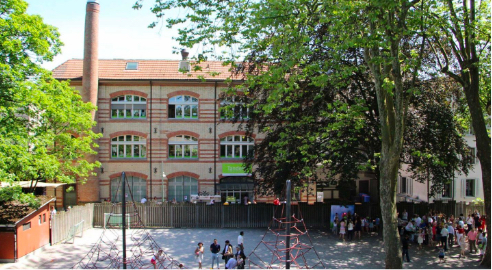The magnificent country of Switzerland, with its variety in culture, tradition, and landscape, doesn’t fail once again to captivate us with its beautiful folk narratives and myths. From epic heroes, sacred animals, dragons, witches, and many more, these fascinating characters have remained in history and tradition through their tales. Further, we have listed the most famous out of the many of Switzerland’s folklore and mythology figures.
Dwarfs
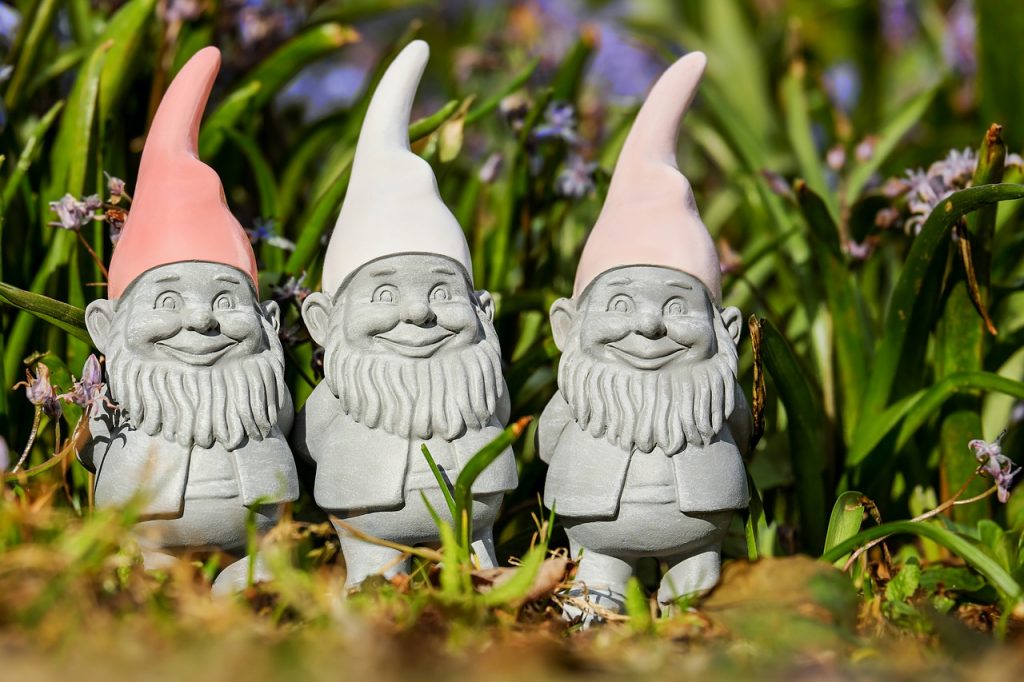
Switzerland’s landscape of hills and mountains seems to have been the ideal habitat for the mythological little men of Swiss alpine folk tales. The men called dwarfs are said to have lived in the earth and hills and are often called ‘earth-men’ for this very reason. They are depicted as kind, wise, and generous beings that busied themselves with agricultural work, mining, crafting, and smithing.
Some countries often portray dwarfs as beings that were vengeful in cases. However, the little Swiss men seem to be positively portrayed as creatures of aid in agriculture, sheltered stray animals, and helped poor children with fruit and firewood to keep them warm. Some joke that Swiss people are like dwarfs themselves: they collect gold, make sophisticated machines and weapons, and are not concerned about the wars of men.
Vogel Gryff in Basel
Vogel Gryff is a Swiss folklore tale of rivalry between the two parts of the city of Basel: Kleinbasel (Lesser Basel), the smaller part of town on the northern side of the Rhine river, and Grossbasel (Greater Basel), the part that often looked down on the other. Kleinbasel recognizes its Honorable Societies or guilds and celebrates them through the festive day of Vogel Gryff each year. The stone bridge on the Rhine River joins the two parts of the city in 1225, yet on this day, Kleinbasel dramatizes its old spite for the other side of the city through traditional dances in the sound of drums and turning their backs on Grossbasel.
The Vogel Gryff or ‘Griffin,’ whom this day is named after, is one of the three Honorable Societies, along with the mythical creatures of Wild Maa (Wild Man) and the Leu (Lion). Vogel Gryff is recognized in Swiss mythology as a half lion and half eagle creature, now a symbol of spirit and freedom for the people of the city.
Basel’s Basilisks
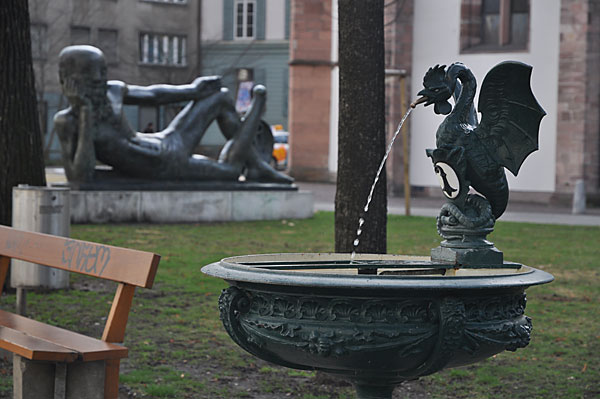
The creature, often described as a crested snake, part reptile, and part bird, is another important symbol for the city of Basel. The basilisk is said to have had the ability to kill you with its look and its breath, while itself it can only be killed by a weasel, its own reflection, or the crow of a cockerel.
The legend says that the basilisk once lived in a cave where the Gerber Brunnen (the tanner’s fountain) is today. An inscription can be found In the fountain, which tells the story of how a cockerel was sentenced to death in the city in 1474, after un-naturally having laid an egg that the citizens feared would hatch into a basilisk. The animal now lives symbolically in Basel, and you can find it in many places around the city as a monument or decor.
The Dragons of Mount Pilatus
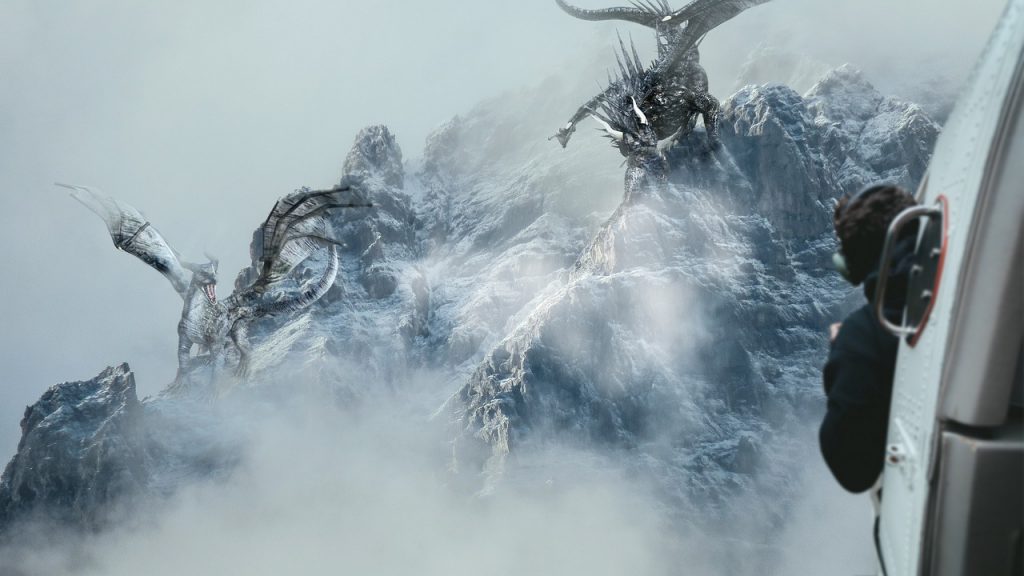
The infamous Mount Pilatus and its fascinating past haunted by dragons and demons is now a site that attracts mythology enthusiasts for both the tales and the sights it offers. Known also as the ‘Dragon Mountain,’ the mountain massif overlooking the city of Lucerne is full of tales of serpentine creatures that are said to have lived in them.
A 1619 chronicle narrates the story of a man’s sight of these dragons in “a great rock in the mound called Pilatus toward another cave, known as “Flue.” Another story from the summer of 1421 talks of a gigantic dragon that flew to the mountain and crashed to the ground so close that one of the farmers nearby named Stempflin fainted in shock. When he became conscious, he found a lump of blood and the Stone of the Dragon, which was then declared to have healing powers.
Harder-Potschete in Interlaken
Ancient folklore in Interlaken calls for celebration or rather a fear-inducing procession that signifies the light’s victory over the darkness of the night every year on the second of January. Masked people representing the cult of the dead march in the streets of Interlaken to spark mock fear and dread among the spectators. Hardermannli, the spirit of the Harder Kulm mountain, together with his wife and their children, the Potschen, wear handmade wooden carved masks to represent the deceased who sought offerings as a form of blessing for a good year to come.
The Devil’s Bridge
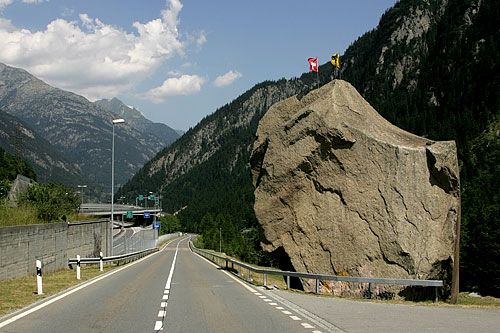
Local villagers near the Reuss Valley in the canton of Uri wanted to build a stone bridge in the Schöllenen Gorge. The story recalls them coming across a stranger—the devil himself—that offered to build it for them. In exchange, he demanded a first sacrificial soul that would cross the bridge. The villagers sent a goat instead of the human sacrifice that the devil sought and angered the devil, who hurled a rock in an attempt to destroy the finished bridge. The stone falls into the canyon instead, and he misses. The legend of the Teufelsbrücke goes back to 1587, and to this day, the 8 meter stone is still there as you pass the motorway at the Gotthard Tunnel entrance.
The Witch of Belalp
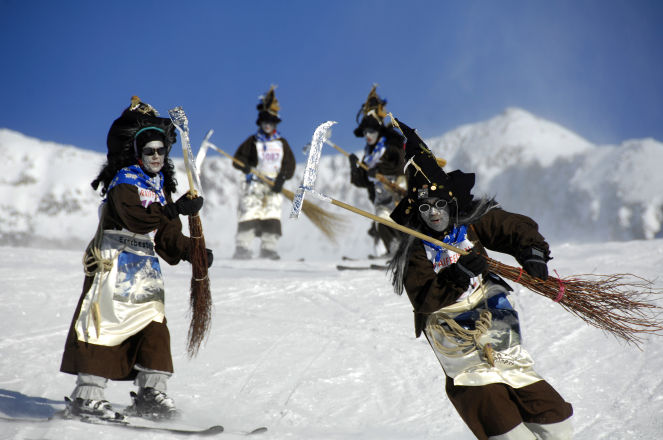
Switzerland has a reputation for being the country that executed presumed witches longer than any country in Europe. Witch trials began around the early 15th century and were a common practice for years. One of the stories that remained is that of the Witch of Belalp. According to legend, she was burned at stake after being accused of murdering her husband after cheating on him with a sorcerer.
This has now sparked a tradition in the area of Blatten – Belalp, where around 1500 skiers take part in the week-long event known as the “Witches Descent.” The popular sport in Switzerland makes for an event of a 12 km race down the slopes starting from Hohstock and ending in the village of Blatten. The skiers dress up as witches and wear interesting masks to commemorate this annual event and the story of the witch of Belalp.
The Giant Gargantua of Matterhorn
Swiss alpine folk tales would not be what they are without the legendary giants of the country’s alps. The Matterhorn, the home of one of the most famous giants, is among Switzerland’s top attractions and consequently one of its highest mountains. The legend behind him involves a giant called the Gargantua, whom the stories recollect as the one who left a mark through his footsteps on the gorgeous landscapes across the country.
This epic figure was a powerful man with long hair that disappeared in the clouds and a massive body that trembled the earth as he walked. During his journey in the region, he collapsed and fell, leaving behind only the part of the mountain between his legs. That peak in the shape of a triangle is now the Matterhorn, a 4474 meters high climb. Gargantua’s heavy footsteps can now be seen as traces in the rocks of the legendary mountain.
Heidi
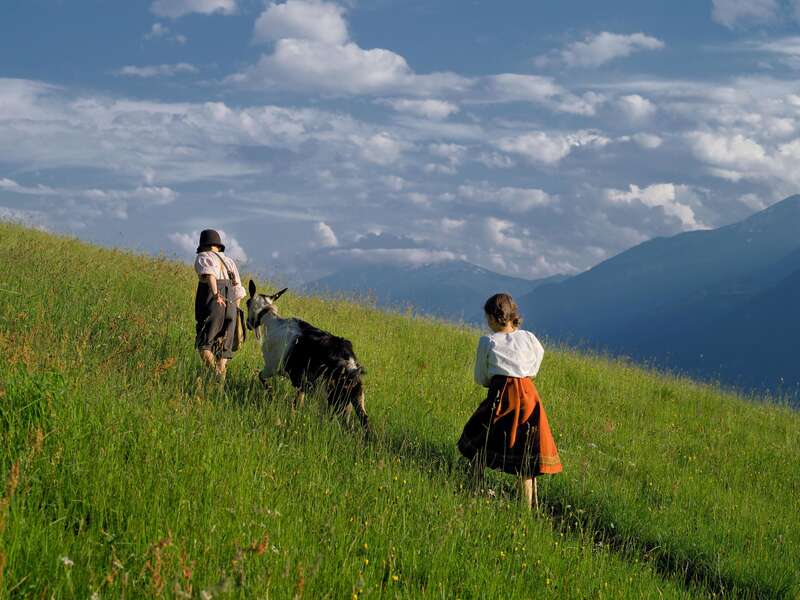
This famous little girl’s story and character have now become an embodiment of the Swiss Alps and spirit. The fiction work with the same name “Heidi” of Johanna Spyri was published in 1879 and 1881 and gained massive popularity ever since. Heidi has now turned into a Swiss myth that still captivates readers and audiences from all over the world, generation to generation. The orphan girl’s story of getting to live in the Swiss mountains lives on to share a message and inspiration for idyllic life, the importance of a positive attitude, altruism, and humankind’s love for nature and their surroundings.
William Tell
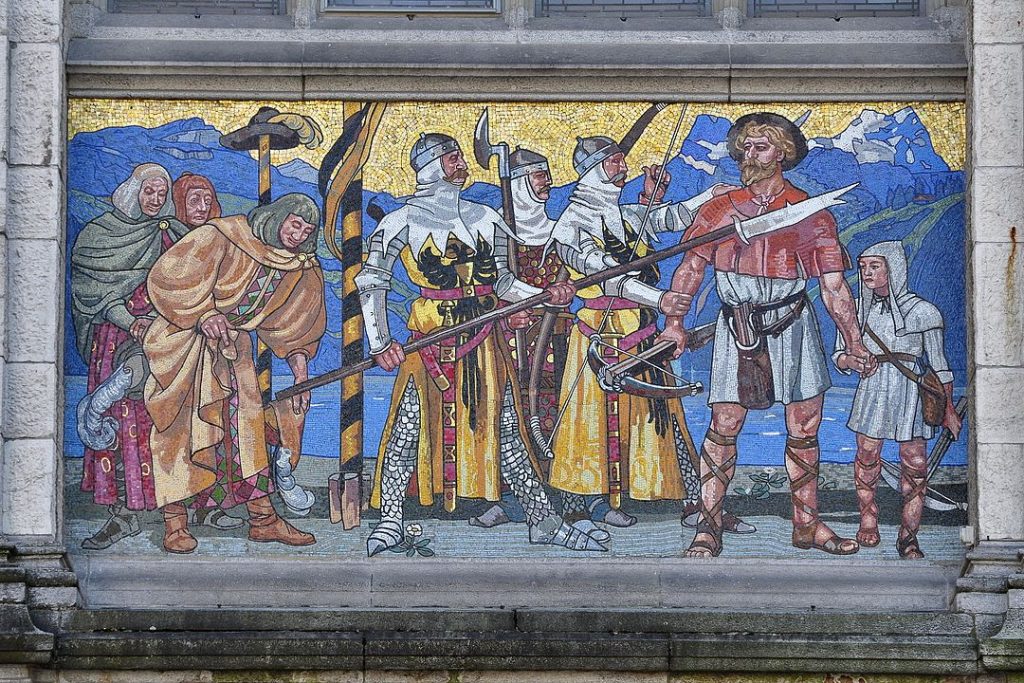
William Tell (Wilhelm Tell in German) is a Swiss hero and legend who apparently was a 13th or early 14th-century peasant from Bürglen in the canton of Uri in Switzerland. His story now stands and inspires for individuality and bravery to stand up to one’s oppressor. According to the stories, he resisted Austrian authorities and their leader Gessler after being forced to shoot an apple on his son’s head with his crossbow. He was known for his talent in archery, which is why he was successful in the challenge and threatened to kill the Austrian with his spare bolt. He was arrested at that very moment but later succeeded in killing the governor to become a resistance figure for Switzerland’s people.
Each of these figures bears great importance in the way Swiss culture came to be shaped. We hope you enjoyed reading and share our fascination with these vivid characters.
Frequently Asked Questions (FAQs)
Who is Schmutzli?
Schmutzli is a figure in Swiss Christmas tradition. He is portrayed as a dark and dirty character who accompanies Samichlaus (Saint Nicholas). Schmutzli’s role is to punish children who have been bad while Samichlaus rewards the good ones.
What is the tale of the Tatzelwurm?
The Tatzelwurm, also known as the Stollenwurm or Springwurm, is a mythical creature from Swiss and German Alpine folklore. It’s often described as a serpent-like creature with a cat-like head and is feared for its venomous breath or bite. Sightings and tales of the Tatzelwurm date back centuries.
Does Swiss folklore influence current Swiss culture?
Absolutely. Swiss folklore still plays a significant role in Switzerland’s cultural identity. Many traditions, festivals, and celebrations are rooted in these folk stories, and elements from Swiss myths can often be found in literature, music, and art.
Are there any books on Swiss folklore and mythology?
Yes, there are several books that delve into Swiss folklore and mythology. Some examples include “Swiss Folk Tales” by Otto Sutermeister, “Folklore and Legends: Switzerland” by Charles John Tibbits, and “Legends of Switzerland” by Zsolt Aradi.
What’s unique about Swiss folklore compared to other European countries’ folklore?
Swiss folklore is deeply influenced by the country’s mountainous landscape, and many of the tales revolve around the Alpine environment and rural life. Its cultural crossroads position in Europe also means Swiss folklore incorporates elements from German, French, Italian, and Romansh traditions, reflecting the diverse linguistic and cultural groups in Switzerland.
How is Swiss folklore passed down through generations?
Swiss folklore has traditionally been passed down orally, though many tales and legends have now been recorded in books. Additionally, folklore is kept alive through traditional festivals, parades, and customs that often reenact these tales and myths.
Is there a Swiss equivalent to fairies or elves?
Yes, in Swiss legends, there are beings known as the “Nature Spirits” or “Elementals”. They are considered to be similar to the concept of fairies or elves in other traditions. The tales tell of small, magical creatures that either help or hinder humans, depending on how they are treated.
Are there any mythical creatures in Swiss legends associated with lakes or bodies of water?
Yes, one such creature is the water sprite or Nix, a shape-shifting entity said to inhabit bodies of water and often associated with drownings.
What are some Swiss festivals associated with folklore and mythology?
Switzerland has several festivals tied to its folklore. One of the most notable is the Fasnacht Carnival in Basel, which involves masks, lanterns, and parades. Another is the Klausjagen festival in Küssnacht, where people parade through the town with cowbells and giant illuminated bishop’s mitres to scare away evil spirits.
How does Swiss folklore vary by region?
Given the country’s linguistic and cultural diversity, Swiss folklore can vary significantly by region. The German-speaking regions, for example, have the legend of the Alpsegen, songs to protect against evil spirits in the mountains, while the French-speaking regions have tales of the Dahu, a mythical goat-like creature.
What role do animals play in Swiss folklore?
Animals are often featured in Swiss folklore, either as magical creatures like the Tatzelwurm or as regular animals with unique roles or attributes. The Dahu, for instance, is a goat-like creature said to have legs shorter on one side than the other for ease of movement on steep mountainsides.
Is there a Swiss version of the Devil in folklore?
The Devil does appear in some Swiss tales, often as a trickster figure. One of the most famous stories is “The Devil’s Bridge,” where the Devil agrees to build a bridge for villagers in exchange for the soul of the first one to cross it.
How does Swiss folklore represent the seasons?
Swiss folklore often reflects the changing of the seasons. For instance, the “Wild Hunt” represents the harshness of winter, while the springtime “Maypole” tradition brings the community together to celebrate the return of fertility to the land.
How has Swiss folklore influenced Swiss literature?
Swiss folklore has deeply influenced Swiss literature, providing a rich source of inspiration for writers. From the William Tell legend popularized by Friedrich Schiller to the folk tales gathered by authors like Otto Sutermeister, these stories offer unique insights into Swiss culture and history.


